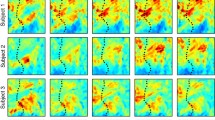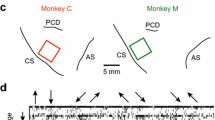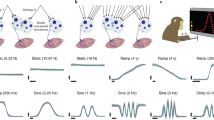Abstract
The role of the motor cortex in the control of both the direction and magnitude of dynamic force, when both are allowed to vary in 3D, is not known. We recorded the activity of 504 cells in the motor cortex of two monkeys during a behavioral task in which the subjects used a manipulandum to vary both the direction and magnitude of isometric force in 3D space. The majority (86%) of cells active in the task related to the direction, a tiny number (2.5%) to the magnitude, and a moderate number (11.5%) to both the direction and magnitude of dynamic force output. Finally, we compared neural activity in the same population of neurons during dynamic and static force output and found that the relations to direction and magnitude were very similar in both epochs. Our results indicate that during dynamic force production, cells in the motor cortex are primarily concerned with specifying the direction of force. The magnitude signal is not prominent in motor cortex neurons, and in general, magnitude and direction of force are specified together. Furthermore, the data suggest that the control of static and dynamic motor systems is based, to a great extent, on a common control process.










Similar content being viewed by others
References
Alexander GE, Crutcher MD (1990) Preparation for movement: neural representations of intended direction in three motor areas of the monkey. J Neurophysiol 64:133–149
Ashe J (1997) Force and the motor cortex. Behav Brain Res 87:255–269
Bhat RB, Sanes JN (1998) Cognitive channels computing action distance and direction. J Neurosci 18:7566–7580
Boline J, Ashe J (1997) Relations between neural activity in parietal area 2/5 and the direction and magnitude of isometric force. Abstr Soc Neurosci 23:1399
Caminiti R, Johnson PB, Urbano A (1990) Making arm movements within different parts of space: Dynamic aspects in the primate motor cortex. J Neurosci 10:2039–2058
Caminiti R, Johnson PB, Galli C, Ferraina S, Burnod Y, Urbano A (1991) Making arm movements within different parts of space: the premotor and motor cortical representation of a coordinate system for reaching at visual targets. J Neurosci 11:1182–1197
Cheney PD, Fetz EE (1980) Functional classes of primate corticomotoneuronal cells and their relation to active force. J Neurophysiol 44:773–791
Evarts EV (1968) Relation of pyramidal tract to force exerted during voluntary movement. J Neurophysiol 31:14–27
Evarts EV (1969) Activity of pyramidal tract neurons during postural fixation. J Neurophysiol 32:375–385
Evarts EV, Fromm C, Kroller J, Jennings VA (1983) Motor cortex control of finely graded forces. J Neurophysiol 49:1199–1215
Favilla M, Hening W, Ghez C (1989) Trajectory control in targeted force impulses. VI. Independent specification of response amplitude and direction. Exp Brain Res 75:280–294
Fetz EE, Cheney PD (1980) Postspike facilitation of forelimb muscle activity by primate corticomotoneuronal cells. J Neurophysiol 44:751–772
Flanders M, Herrmann U (1992) Two components of muscle activation: scaling with the speed of arm movement. J Neurophysiol 67:931–943
Flanders M, Soechting JF (1990) Arm muscle activation for static forces in three-dimensional space. J Neurophysiol 64:1818–1837
Fromm C (1983) Changes of steady state activity in motor cortex consistent with the length-tension relation of muscle. Pflugers Arch 398:318–323
Fu QG, Suarez JI, Ebner TJ (1993) Neuronal specification of direction and distance during reaching movements in the superior precentral premotor area and primary motor cortex of monkeys. J Neurophysiol 70:2097–2116
Fu QG, Flament D, Coltz JD, Ebner TJ (1995) Temporal encoding of movement kinematics in the discharge of primate primary motor and premotor neurons. J Neurophysiol 73:836–854
Georgopoulos AP, Ashe J (2000) One motor cortex, two different views. Nat Neurosci 10:963
Georgopoulos AP, Kalaska JF, Caminiti R, Massey JT (1982) On the relations between the direction of two-dimensional arm movements and cell discharge in primate motor cortex. J Neurosci 2:1527–1537
Georgopoulos AP, Kettner RE, Schwartz AB (1988) Primate motor cortex and free arm movements to visual targets in three-dimensional space. II. Coding of the direction of movement by a neuronal population. J Neurosci 8:2928–2937
Georgopoulos AP, Ashe J, Smyrnis N, Taira M (1992) Motor cortex and the coding of force. Science 256:1692–1695
Ghez C, Gordon J, Ghiraldi MF, Christakos CN, Cooper CN (1990) Roles of proprioceptive input in the programming of arm trajectories. Cold Spring Harb Symp Quant Biol 55:837–847
Ghez C, Favilla M, Ghilardi MF, Gordon J, Bermejo R, Pullman S. (1997) Discrete and continuous planning of hand movements and isometric force trajectories. Exp Brain Res 115:217–233
Goodman D, Kelso JAS (1980) Are movement prepared in parts? not under compatible (naturalized) conditions. J Exp Psychol Gen 109:475–495
Hepp-Reymond MC, Diener R (1983) Neural coding of force and of rate of force change in the precentral finger region of the monkey. Exp Brain Res Suppl 7:315–326
Hepp-Reymond MC, Wyss UR, Anner R (1978) Neuronal coding of static force in the primate motor cortex. J Physiol 74:287–291
Humphrey DR, Reed DJ (1983) Separate cortical systems for control of joint movement and joint stiffness: reciprocal activation and coactivation of antagonist muscles. Adv Neurol 39:347–372
Humphrey DR, Schmidt EM, Thompson WD (1970) Predicting measures of motor performance from multiple cortical spike trains. Science 170:758–762
Kakei S, Hoffman DS, Strick PL (1999) Muscle and movement representations in the primary motor cortex. Science 285:2136–2139
Kalaska JF, Cohen DAD, Hyde ML, Prud’homme M (1989) A comparison of movement direction-related versus load direction-related activity in primate motor cortex, using a two-dimensional reaching task. J Neurosci 9:2080–2102
Kurata K (1993) Premotor cortex of monkeys: set- and movement-related activity reflecting amplitude and direction of wrist movement. J Neurophysiol 69:187–200
Kurtzer I, Herter T, Scott SH (2004) Single unit discharges within primary motor cortex reveal independent representations of load during posture and movement. Program No. 655.4. 2004 Abstract Viewer/Itinerary Planner. Washington, DC: Society for Neuroscience, Online
Larish DD, Frekany GA (1995) Planning and preparing expected and unexpected movements: reexamining the relationships of arm, direction and extend of movement. J Mot Behav 17:168–189
Maier MA, Bennett KMB, Hepp-Reymond MC, Lemon RN (1993) Contribution of the monkey corticomotoneuronal system to the control of force in precision grip. J Neurophysiol 69:772–785
Mardia KV (1972) Statistics of directional data. Academic, London
Martin JH, Ghez C (1985) Task-related coding of stimulus and response in cat motor cortex. Exp Brain Res 57:427–442
Massey JT, Hovey GW, Schneider W, Chubbuck JG, Georgopoulos AP (1988) A method for studying the control of three-dimensinal isometric forces using dynamic stereogram. J Neurosci Methods 26:123–127
Messier J, Kalaska JF (2000) Covariation of primate dorsal premotor cell activity with direction and amplitude during a memorized-delay reaching task. J Neurophysiol 84:152–165
Moran DW, Schwartz AB (1999) Motor cortical representation of speed and direction during reaching. J Neurophysiol 82:2676–2692
Mountcastle VB, Reitboeck HJ, Poggio GF, Steinmetz MA (1991) Adaptation of the Reitboeck method of multiple microelectrode recording to the neocortex of the waking monkey. J Neurosci Methods 36:77–84
Pellegrini JJ, Flanders M (1996) Force path curvature and conserved features of muscle activation. Exp Brain Res 110:80–90
Riehle A, Requin J (1989) Monkey primary motor and premotor cortex: single-cell activity related to prior information about direction and extent of an intended movement. J Neurophysiol 61:534–549
Riehle A, MacKay WA, Requin J (1994) Are extent and force independent movement parameters? Preparation- and movement-related neuronal activity in the monkey cortex. Exp Brain Res 99:56–74
Schwartz AB (1993) Motor cortical activity during drawing movements: population representation during sinusoid tracing. J Neurophysiol 70:28–36
Schwartz AB, Kettner RE, Georgopoulos AP (1988) Primate motor cortex and free arm movements to visual targets in three-dimensional space. I. Relations between single cell discharge and direction of movement. J Neurosci 8:2913–2927
Scott SH, Kalaska JF (1997) Changes in motor cortex activity during reaching movements with similar hand paths but different arm postures. J Neurophysiol 73:2563–2567
Scott SH, Gribble PL, Graham KM, Cabel DW (2001) Dissociation between hand motion and population vectors from neural activity in motor cortex. Nature 413:161–165
Sergio LE, Kalaska JF (2003) Systematic changes in motor cortex cell activity with arm posture during directional isometric force generation. J Neurophysiol 89:212–228
Smith AM, Hepp-Reymond MC, Wyss UR (1975) Relation of activity in precentral cortical neurons to force and rate of force change during isometric contractions of finger muscles. Exp Brain Res 23:315–332
Snedecor GW, Cochrane WG (1989) Statistical Methods. Iowa State University Press, Ames
Soechting JF, Flanders M (1989) Sensorimotor representations for pointing to targets in three-dimensional space. J Neurophysiol 62:582–594
Taira M, Boline J, Smyrnis N, Georgopoulos AP, Ashe J (1996) On the relations between single cell activity in the motor cortex and the direction and magnitude of three-dimensional static isometric force. Exp Brain Res 109:367–376
Thach WT (1978) Correlation of neural discharge with pattern and force of muscular activity, joint position, and direction of intended next movement in motor cortex and cerebellum. J Neurophysiol 41:654–676
Todorov E (2000) Direct cortical control of muscle activation in voluntary arm movements: a model. Nat Neurosci 3:391–398
Turner RS, Anderson ME (1997) Pallidal discharge related to the kinematics of reaching movements in two dimensions. J Neurophysiol 77:1051–1074
Wannier TM, Maier MA, Hepp-Reymond MC (1991) Contrasting properties of monkey somatosensory and motor cortex neurons activated during the control of force in precision grip. J Neurophysiol 65:572–589
Wenzelburger R, Kopper F, Frenzel A, Stolze H, Klebe S, Brossmann A, Kuhtz-Buschbeck J, Golge M, Illert M, Deuschl G (2005) Hand coordination following capsular stroke. Brain 128:64–74
Author information
Authors and Affiliations
Corresponding author
Additional information
The work was supported in part by a Merit Review award from the Department of Veterans Affairs and by the American Legion Brain Sciences Chair.
Rights and permissions
About this article
Cite this article
Boline, J., Ashe, J. On the relations between single cell activity in the motor cortex and the direction and magnitude of three-dimensional dynamic isometric force. Exp Brain Res 167, 148–159 (2005). https://doi.org/10.1007/s00221-005-0016-z
Received:
Accepted:
Published:
Issue Date:
DOI: https://doi.org/10.1007/s00221-005-0016-z




